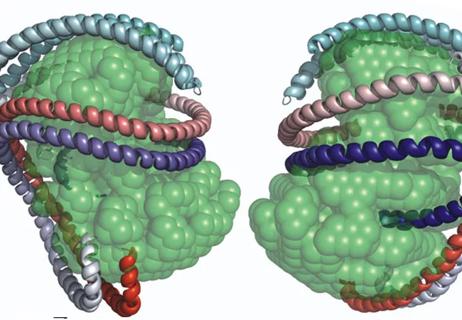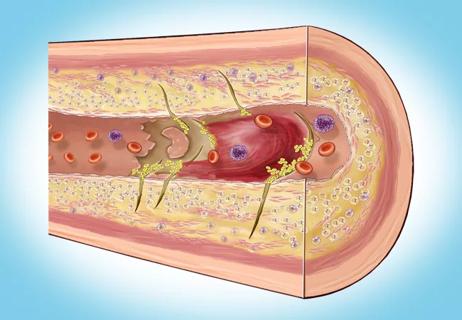Robust reductions in cardiac events seen in high-risk patients without prior events

The lipid-lowering medication bempedoic acid (Nexletol®) was associated with a significant reduction in major cardiovascular events among patients taking it for primary cardiovascular prevention, according to a prespecified subgroup analysis of the large multicenter CLEAR Outcomes trial.
Advertisement
Cleveland Clinic is a non-profit academic medical center. Advertising on our site helps support our mission. We do not endorse non-Cleveland Clinic products or services. Policy
The findings, presented at the 2023 scientific sessions of the American Diabetes Association in San Diego and simultaneously published online in JAMA, represent a wake-up call for clinicians and patients, according to the study’s presenter and first author, Steven Nissen, MD.
“We saw a 30% reduction in the primary composite endpoint with bempedoic acid relative to placebo,” says Dr. Nissen, Chief Academic Officer of Cleveland Clinic’s Heart, Vascular & Thoracic Institute. This compares favorably with the 13% reduction seen in the overall CLEAR Outcomes trial, which included both primary and secondary prevention populations.
“We also saw 39% reductions in both myocardial infarction (MI) and cardiovascular death,” Dr. Nissen continues. “Yet less than half of U.S. adults who are candidates for lipid-lowering therapy for primary prevention actually receive it. This is a wake-up call that we need to pay more attention to treating these patients, because the benefits to be gained are very large.”
“Much of the data surrounding newer lipid-lowering therapies has focused on patients with prior atherosclerotic cardiovascular events,” adds study co-author Luke Laffin, MD, staff in Cleveland Clinic’s Section of Preventive Cardiology. “The data from this analysis underscore the importance of lowering LDL cholesterol (LDL-C) among individuals who have not yet had a stroke, heart attack, stent or bypass surgery.”
As reported earlier this year (N Engl J Med. 2023;388:1353-1364), CLEAR Outcomes was a masked clinical trial that randomized a mixed population of 13,970 primary and secondary prevention patients with statin intolerance to oral bempedoic acid (180 mg/day) or matching placebo. Thirty percent of the population, or 4,206 patients, had no prior cardiovascular events but had clinical features that put them at high risk for an event; these patients made up the primary prevention cohort for this prespecified subgroup analysis.
Advertisement
The primary endpoint was a composite of cardiovascular death, nonfatal MI, nonfatal stroke or coronary revascularization.
The primary prevention cohort was 59% female and had a mean age of 68 years. Two-thirds of patients (66%) had diabetes.
Mean LDL-C at baseline was 142.2 mg/dL in the bempedoic acid group and 142.7 mg/dL in the placebo group. After six months of treatment, the mean LDL-C was 30.2 mg/dL lower in the bempedoic acid group than in the placebo group. After 12 months of treatment, the bempedoic acid group had a reduction of 21.5% in high-sensitivity C-reactive protein levels compared with the placebo group (from a baseline of 2.4 mg/L in both groups).
Over median follow-up of 39.9 months, key clinical outcomes were as follows:
No differences between groups were observed in serious adverse events or events leading to drug discontinuation. The incidence of several adverse effects was higher with bempedoic acid than with placebo: gout (2.6% vs. 2.0%), cholelithiasis (2.5% vs. 1.1%), and elevations in serum creatinine, uric acid and hepatic enzymes.
Advertisement
The number needed to treat (NNT) to prevent one occurrence of the primary endpoint was 43. “Any NNT value below 50 represents a large treatment effect,” says Dr. Nissen. He adds that bempedoic acid’s treatment effect was greater in the CLEAR Outcomes trial’s primary prevention cohort than in its secondary prevention cohort.
Dr. Nissen notes that it had been 15 years since the last major outcomes study of a cholesterol-lowering drug for primary prevention — the JUPITER study of rosuvastatin — was published. “Event rates are higher in secondary prevention trials, which means that studies can be completed more quickly and with smaller sample sizes in secondary prevention than in primary prevention,” he explains. “That’s why fewer studies of lipid lowering for primary prevention have been done. But that has contributed to the unacceptably low rates of treatment of lipids for primary prevention.”
In their study report, the investigators note the particular significance of their results for patients with diabetes, given that diabetes was an enrollment criterion for increased cardiovascular risk and two-thirds of patients in the analysis had diabetes. “The current findings support the guideline recommendation that primary prevention patients with diabetes should be treated with statins to lower cholesterol levels,” the authors write. Guidelines do not currently address use of nonstatin medications for primary prevention in high-risk patients.
“I tell all my patients who have elevated LDL-C — often with a family history of cardiovascular disease or other cardiovascular risk factors — first that we need to make sure lifestyle factors are controlled but second that they will be on lipid-lowering therapy at some point because it further lowers their risk of future strokes and heart attacks,” says Dr. Laffin. “Bempedoic acid is a useful agent in patients who cannot tolerate statins due to side effects, and now we have data demonstrating that it can be a useful tool for primary prevention.”
Advertisement
“What would you rather do?” asks Dr. Nissen. “Treat a patient after they’ve had an event or prevent them from having the event in the first place?”
The trial was funded by Esperion Therapeutics, which markets bempedoic acid, and coordinated by the Cleveland Clinic Coordinating Center for Clinical Research (C5Research).
Advertisement
Advertisement

First-in-human phase 1 trial induced loss of function in gene that codes for ANGPTL3

Phase 3 TANDEM study may help pave way to first approval of a CETP inhibitor

Reassurance from the lipid outcomes trial with the highest percentage female enrollment to date

Tech-assisted self-selection concurred with clinician-assessed eligibility in >90% of cases

Newly identified pathway may explain the so-called niacin paradox

High plasma ApoA1 and TG/HDL-C ratio predict faster progression

Inflammation found more predictive of events than LDL-C in pooled analysis of RCTs

Findings bolster the oral drug as an option for primary and secondary prevention